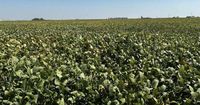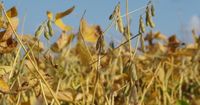As the sun set over Caleb Ragland’s Kentucky farm on September 29, 2025, the scene was anything but tranquil. Ragland, president of the American Soybean Association, juggled a phone interview while helping his son Carter in the combine—harvesting what he called one of the most challenging crops of his career. “Our corn yields are about 25% below APH (average production history) … and soybean yields are kind of all over the board,” Ragland told AgriTalk host Chip Flory. The culprit? A year of weather extremes—excessive spring rains followed by a stubborn drought that began just after July 4 and refused to let up. “I’m thankful yields aren’t lower than what they are,” he admitted. “It’s disappointing but not unexpected.”
But the weather was just the beginning of Ragland’s worries. 2026, he predicted, would be a year of extremes not only for crop yields but for U.S. soybean trade policy as well. The reason: a dramatic drop in soybean sales to China, America’s largest export market. According to the American Soybean Association, China’s pivot away from U.S. soybeans—partly a result of ongoing retaliatory tariffs and unresolved trade disputes—has left American farmers caught between global political titans. “Unfortunately, I think that’s the situation we’re in, and that doesn’t have a likely, quick, positive outcome,” Ragland said. “But it’s pretty obvious that if we had the opportunity price wise, that our soybeans would sell, but I think that it’s likely a long battle that we’re in for here.”
The tension escalated when the Trump administration pledged a $20 billion economic rescue package for Argentina. Almost immediately, Argentina sold 20 shiploads of soybeans to China, a move that stung U.S. producers already reeling from lost sales. Senator Chuck Grassley of Iowa voiced the frustration of many: “Why would USA help bail out Argentina while they take American soybean producers’ biggest market??? We shld use leverage at every turn to help hurting farm economy Family farmers shld be top of mind in negotiations by representatives of USA,” he posted on X (formerly Twitter) on September 25, 2025.
The numbers paint a grim picture. ASA economist Scott Gerlt estimated that U.S. soybean growers would lose “well over” $100 per acre in 2025. The economic pain rippled outward, hitting rural communities especially hard. As Ragland explained, when farmers spend money locally, those dollars turn over six to eight times, supporting small businesses and the broader rural economy. But with China’s market closed, that vital economic engine sputtered.
President Donald Trump, meanwhile, sought to reassure farmers. On September 25, 2025, he announced from the White House that tariff revenue collected would be used to provide financial aid to those hurt by the ongoing trade war. “We’re going to take some of that tariff money that we made, we’re going to give it to our farmers, who are, for a little while, going to be hurt until the tariffs kick into their benefits,” Trump said. “So we’re going to make sure that our farmers are in great shape, because we’re taking in a lot of money.”
If this all sounds familiar, it’s because it is. As reported by multiple outlets, Trump’s first administration saw a similar cycle: a trade war with China, followed by a $23 billion bailout for farmers in 2018-2019. The pattern—trade disruption, surplus crops, financial losses, and then government relief—has become a frustrating refrain for many in agriculture. “See a pattern here?” one AI-generated newsroom summary quipped, likening Trump’s approach to a firefighter who sets the blaze just to be the one to put it out.
China, for its part, has shifted its sourcing of soybeans and other agricultural products away from the U.S., turning instead to countries like Brazil and, more recently, Argentina. This shift has left American growers with unsold surpluses and mounting financial losses. The Midwest’s soybean farmers still remember the $9.4 billion in losses they racked up during the 2018 trade war, according to past reporting. California’s tree nut growers—who export 70% of their almonds and nearly 80% of their pistachios—lost $239 million in 2018 due to similar trade impacts. Fresno County, where almonds and pistachios alone are valued at nearly $2 billion, felt the sting acutely.
Despite the mounting evidence, Agriculture Secretary Brooke Rollins, speaking in Missouri in late September 2025, attributed rising agricultural costs to increases in seed, fuel, fertilizer, and interest payments since 2020. She made no mention of tariffs as a contributing factor. “President Trump has made it clear: America’s farmers and ranchers will never be left behind,” Rollins said. “The success of our farmers is a national security priority, and at USDA we are looking at every option to ensure the future viability of American agriculture.” Instead, Rollins pointed to the previous administration’s policies as the real culprit, blaming them for driving up inflation and failing to open new markets abroad. “The last administration’s policies drove up inflation and ignored the needs of farmers and ranchers while not opening new markets abroad,” she said. “The cost of doing business for farmers and ranchers increased dramatically, and commodity prices slumped. The Trump administration is holding these companies accountable and will investigate why input prices have not come back down.”
But for many farmers, the issue is less about input costs and more about lost market access. “We have to have opportunities within the market. That’s key, but we’ve got to have a level playing field,” Ragland insisted. He’s been vocal about not wanting farmers to become dependent on government aid. “Farmers don’t want to be dependent on the government for aid to meet their financial obligations,” he’s said repeatedly this year in both legislative meetings and media appearances.
Still, a farm aid package appears to be in the works. According to reporting by Politico, Trump officials expect Congress will need to authorize the use of tariff revenue for the farm aid package, aiming for inclusion in an omnibus bill due by November 21, 2025. That means cash relief for farmers could start rolling out in early 2026. Yet, as Cornell economist Christopher Barrett told reporters, bailouts rarely match up well with farmers’ actual losses. “The government can cover some of the losses through bailout payments,” Barrett said. “But those rarely match up well with farmers’ actual losses, so it will help some people, but somewhat haphazardly.”
As the debate rages on, one thing is clear: the stakes for America’s farmers couldn’t be higher. With trade policy, weather, and global politics all converging in unpredictable ways, the coming year will test the resilience of rural communities across the country. Whether relief arrives in time—and whether it’s enough—remains to be seen.


